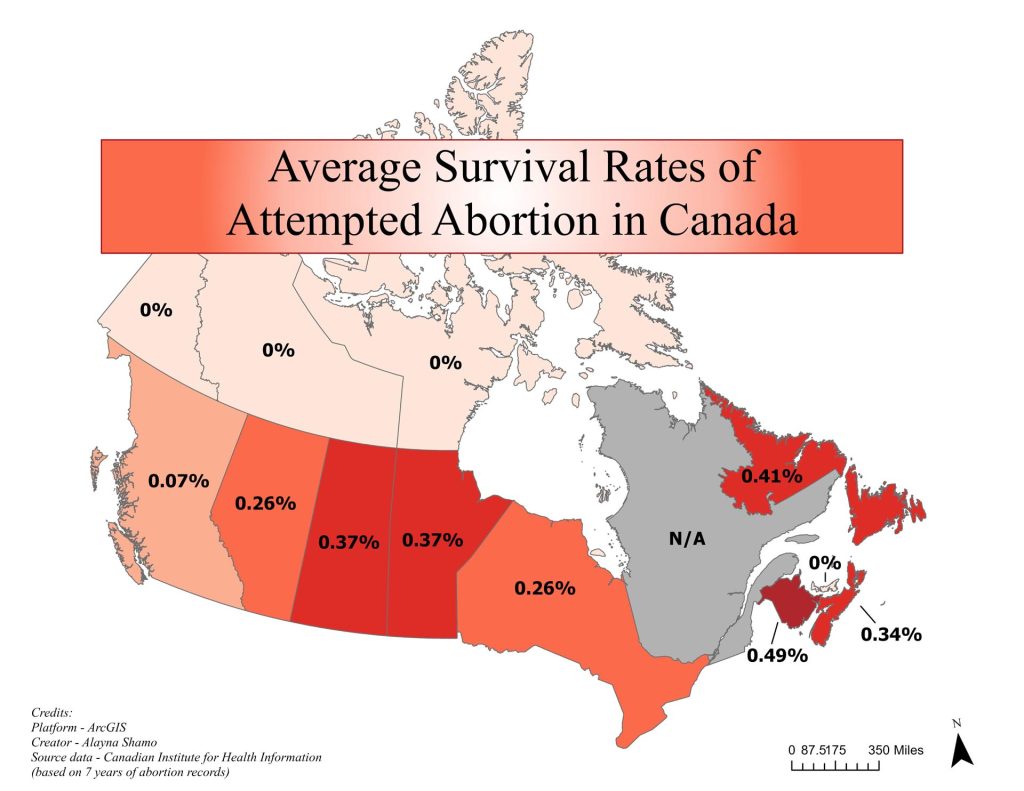Extrapolated Canadian Data
What is covered in this article:
- The definition of a “born alive abortion”
- Inadequate records and data in the US
- Canadian recording processes
- Canadian numbers and rates
- Extrapolations to the US
- The implications
The Definition
A “born alive abortion” is defined as a failed abortion procedure resulting in the live birth of an infant instead of the termination of a pregnancy. Note that not all failed abortions result in a live birth, as many of them lead to a second abortion attempt.
Born alive abortion: A failed abortion procedure resulting in the live birth of an infant
Records in the United States
Currently, only 10 out of 50 states in the US require reporting on born alive abortions. Each of these states has different recording processes. They also have different standards and definitions for what it means to survive an abortion. Some states require an infant to have reached a certain gestational age before they may be considered “born alive,” some have a list of standards, such as umbilical cord pulsation or a beating heart, and others merely state that a born alive infant is an infant alive outside the womb after an abortion procedure.
In other words, the United States uses a separate federal system for recording data that must be recorded consistently for accurate analysis. Not only this, but the majority of states, 40 out of 50, fail to keep any sort of records relative to abortion survivors or born alive abortions. Overall, born alive records are either completely missing or else full of inconsistencies and gaps.
States With Born Alive Recording Requirements and public reports – 2019:
Arizona – 15
Arkansas – 0
Florida – 2
Indiana – 0
Michigan – N/A
Minnesota – 3
Ohio – N/A
Oklahoma – 0
South Dakota – N/A
Texas – 6
Total = 26
*Compiled by The Charlotte Lozier Institute
The Canadian Method
The Canadian Institute for Health Information (CIHI) collects health-related data from the provinces and territories while providing an instruction manual on how data is gathered. CIHI is a federal government funded independent nonprofit organization that informs and analyzes health data. CIHI publicizes statistical reports and quality measurements on cihi.ca. Born alive abortions are recorded as “livebirths from termination of pregnancy” and can be found among other abortion statistics.
Limitations of CIHI data are that chemical abortions are mostly excluded, Quebec does not report born alive numbers, and counts of 1-4 are generally represented as N/R in born alive data tables. Despite these limitations, CIHI offers infinitely more accurate numbers than what can be found in the US, where data is either completely lacking or full of inconsistencies and gaps.
Calculating an Average Rate of Infants Who Survive
The average rate of infants who survive abortions in Canada is calculated by comparing the total number of abortions and the number of born alive abortions. The Abortion Survivors Network has analyzed 7 years of Canadian data and calculated an overall average survival rate of 0.21%.
Average abortion survival rate: 0.21%
See the map below for survival rates in each Canadian province

If This Rate Held True in The United States, How Many Survivors Would There be Each Year?
That is the big question. What are we missing without accurate records?
This can be answered by applying the Canadian rate to the total number of abortions in the US from the CDC and Johnston’s Archive (for 3 states that do not report to the CDC).
The estimated number of born alive abortions for 7 years, based on the Canadian rate that year:
2014 – 1,976
2015 – 1,302
2016 – 1,662
2017 – 1,646
2018 – 1,798
2019 – 1,824
2020 – 1,927
The average number of abortion survivors each year: 1,734

The Implications
Accurate information begins with accurate records. In order for reliable data to be gathered, reliable data must first be recorded, tracked, and tallied. When it comes to abortion, the United States is lacking quality data. Abortion recording requirements in the US are often either missing or else full of inconsistencies and gaps. As things currently stand, the only reasonable estimates must come through extrapolation.
The Abortion Survivors Network alone has connected with over 630 survivors since our founding in 2012. We have been acutely aware of the missing numbers. Through this analysis, it has become apparent that almost 2,000 infants survive abortion every year. However, we are continuing outreach and research to find more survivors and lead to an even clearer understanding of the reality of born alive abortions.
For more information please reach out to Alayna Shamo at Alayna@abortionsurvivors.org
References
“Abortion Rights Coalition of Canada.” Abortion Rights Coalition of Canada, https://www.arcc-cdac.ca/embed/#?secret=fuQuCNcZiq#?secret=9sf3yneKt3 Bureau, US Census. Census.gov, 11 July 2022, https://www.census.gov/. Canadian Institute for Health Information, https://www.cihi.ca/en. Centers for Disease Control and Prevention, Centers for Disease Control and Prevention, https://www.cdc.gov/. Charlotte Lozier Institute. “Questions and Answers on Born-Alive Abortion Survivors.” Charlotte Lozier Institute, 14 Apr. 2021, https://lozierinstitute.org/questions-and-answers-on-born-alive-abortion-survivors/. Discharge Abstract Database (DAD), 2017-2018, Canadian Institute for Health Information Government of Canada, Statistics Canada. “Statistics Canada: Canada's National Statistical Agency.” Statistics Canada: Canada's National Statistical Agency, 12 July 2022, https://www.statcan.gc.ca/en/start. “Mirror, Mirror 2021: Reflecting Poorly.” Commonwealth Fund, 4 Aug. 2021, https://www.commonwealthfund.org/publications/fund-reports/2021/aug/mirror-mirror-202 1-reflecting-poorly. “Pro-Life State Policy Maps.” Family Research Council, https://www.frc.org/prolifemaps
